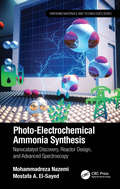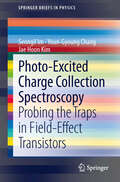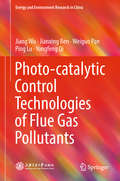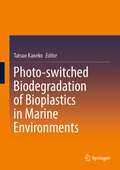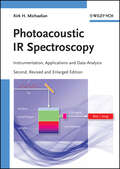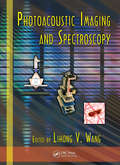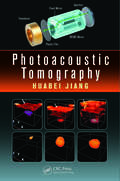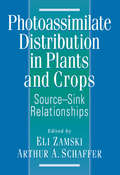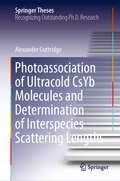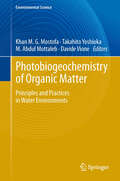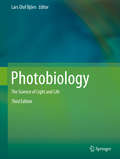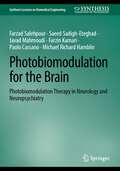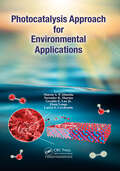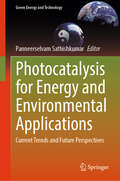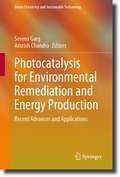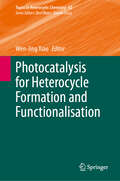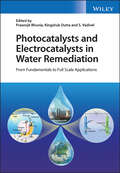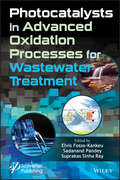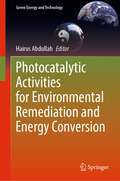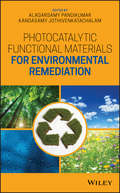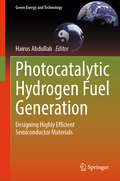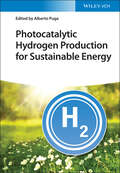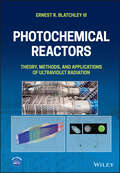- Table View
- List View
Photo-Electrochemical Ammonia Synthesis: Nanocatalyst Discovery, Reactor Design, and Advanced Spectroscopy (Emerging Materials and Technologies)
by Mohammadreza Nazemi Mostafa A. El-SayedAmmonia holds great promise as a carbon-neutral liquid fuel for storing intermittent renewable energy sources and power generation due to its high energy density and hydrogen content. Photo-Electrochemical Ammonia Synthesis: Nanocatalyst Discovery, Reactor Design, and Advanced Spectroscopy covers the synthesis of novel hybrid plasmonic nanomaterials and their application in photo-electrochemical systems to convert low energy molecules to high value-added molecules and looks specifically at photo-electrochemical nitrogen reduction reaction (NRR) for ammonia synthesis as an attractive alternative to the long-lasting thermochemical process. Provides an integrated scientific framework, combining materials chemistry, photo-electrochemistry, and spectroscopy to overcome the challenges associated with renewable energy storage and transport Reviews materials chemistry for the synthesis of a range of heterogeneous (photo) electrocatalysts including plasmonic and hybrid plasmonic-semiconductor nanostructures for selective and efficient conversion of N2 to NH3 Covers novel reactor design to study the redox processes in the photo-electrochemical energy conversion system and to benchmark nanocatalysts’ selectivity and activity toward NRR Discusses the use of advanced spectroscopic techniques to probe the reaction mechanism for ammonia synthesis Offers techno-economic analysis and presents performance targets for the scale-up and commercialization of electrochemical ammonia synthesis This book is of value to researchers, advanced students, and industry professionals working in sustainable energy storage and conversion across the disciplines of Chemical Engineering, Mechanical Engineering, Materials Science and Engineering, Environmental Engineering, and related areas.
Photo-Excited Charge Collection Spectroscopy
by Seongil Im Youn-Gyoung Chang Jae Hoon KimSolid state field-effect devices such as organic and inorganic-channel thin-film transistors (TFTs) have been expected to promote advances in display and sensor electronics. The operational stabilities of such TFTs are thus important, strongly depending on the nature and density of charge traps present at the channel/dielectric interface or in the thin-film channel itself. This book contains how to characterize these traps, starting from the device physics of field-effect transistor (FET). Unlike conventional analysis techniques which are away from well-resolving spectral results, newly-introduced photo-excited charge-collection spectroscopy (PECCS) utilizes the photo-induced threshold voltage response from any type of working transistor devices with organic-, inorganic-, and even nano-channels, directly probing on the traps. So, our technique PECCS has been discussed through more than ten refereed-journal papers in the fields of device electronics, applied physics, applied chemistry, nano-devices and materials science, finally finding a need to be summarized with several chapters in a short book. Device physics and instrumentations of PECCS are well addressed respectively, in the first and second chapters, for the next chapters addressing real applications to organic, oxide, and nanostructured FETs. This book would provide benefits since its contents are not only educational and basic principle-supportive but also applicable and in-house operational.
Photo-catalytic Control Technologies of Flue Gas Pollutants (Energy and Environment Research in China)
by Ping Lu Jiang Wu Weiguo Pan Jianxing Ren Yongfeng QiThis book introduces the theory and applications of nanometer photocatalysis, and it briefly presents the concept of photocatalysts, photocatalytic reaction mechanisms and kinetics, and photocatalytic reactor design. In addition, the use of photocatalysis in the control of flue-gas pollutants is discussed in detail.The book also describes how a photocatalytic reactor is designed and implemented to evaluate the photocatalytic oxidation capacity of different photocatalysts on elemental mercury in a simulated flue gas. After that, the effect of photocatalysts on the SO2, NOx and Hg removal in the flue gas is studied. Photocatalytic cleaning technology can be applied not only in gas pollutant cleaning at power plants, but also in wastewater purification.Readers gain a comprehensive understanding of possible mercury emission control methods and the industrial applications of these technologies.
Photo-switched Biodegradation of Bioplastics in Marine Environments
by Tatsuo KanekoThis book presents the novel concept of photo-switched biodegradation of bioplastics which is one of the important methods to overcome plastic waste issues in oceans. The different chapters discuss topics associated with a wide range of biorefinery plant cultivation, cell bioengineering in silico/wet, plastic design with photo-controlled biodegradation, photocatalysis design, evaluation of biodegradability, polymer toxicity, and plastic edibility. The book contributes to various Sustainable Development Goals such as SDG 14—Life Below Water; SDG 9—Industry, Innovation and Infrastructure; SDG 12—Responsible Consumption and Production; and SDG 15—Life on Land. It is a useful source for academic scientists in the fields of organic chemistry, photocatalysts, organic/inorganic composites, cell biology, plant biology, plastic processing, social control of wastes, environmental science, marine technology, and engineers. The book plays a big part in paradigm-changing innovation and transforms the petrochemical industry which has reached maturity, into a biochemical industry.
Photoacoustic IR Spectroscopy: Instrumentation, Applications and Data Analysis
by Kirk H. MichaelianThis invaluable and up-to-date source on instruments and applications covers everything needed to employ a technique for investigating various gases and materials, including biomaterials. It includes the latest developments in light sources, signal recovery and numerical methods. There is no other single publication that reviews the entire subject of photoacoustic infrared spectroscopy in such detail. Physicists, chemists, and spectroscopists in both academic and industrial laboratories, polymer and organic chemists, analysts in industry, forensic and government laboratories, and materials scientists will find this book to be a vital resource.
Photoacoustic Imaging and Spectroscopy (Optical Science and Engineering)
by Lihong V. WangPhotoacoustics promises to revolutionize medical imaging and may well make as dramatic a contribution to modern medicine as the discovery of the x-ray itself once did. Combining electromagnetic and ultrasonic waves synergistically, photoacoustics can provide deep speckle-free imaging with high electromagnetic contrast at high ultrasonic resolution and without any health risk. While photoacoustic imaging is probably the fastest growing biomedical imaging technology, this book is the first comprehensive volume in this emerging field covering both the physics and the remarkable noninvasive applications that are changing diagnostic medicine. Bringing together the leading pioneers in this field to write about their own work, Photoacoustic Imaging and Spectroscopy is the first to provide a full account of the latest research and developing applications in the area of biomedical photoacoustics. Photoacoustics can provide functional sensing of physiological parameters such as the oxygen saturation of hemoglobin. It can also provide high-contrast functional imaging of angiogenesis and hypermetabolism in tumors in vivo. Discussing these remarkable noninvasive applications and so much more, this reference is essential reading for all researchers in medical imaging and those clinicians working at the cutting-edge of modern biotechnology to develop diagnostic techniques that can save many lives and just as importantly do no harm.
Photoacoustic Tomography
by Huabei JiangThe concept of photoacoustic tomography (PAT) emerged in the mid-1990s, and the field of PAT is now rapidly moving forward. Presenting the research of a well-respected pioneer and leading expert, Photoacoustic Tomography is a first-of-its-kind book covering the underlying principles and practical applications of PAT in a systematic manner. Written in a tutorial format, the text: Addresses the fundamentals of PAT, the theory on photoacoustic effect, image reconstruction methods, and instrumentation Details advanced methods for quantitative PAT, which allow the recovery of tissue optical absorption coefficient and/or acoustic properties Explores the development of several image-enhancing schemes, including both software and hardware approaches Examines array-based PAT systems that are the foundation for the realization of 2-D, 3-D, and 4-D PAT Discusses photoacoustic microscopy (PAM) and combinations of PAT/PAM with other imaging methods Considers contrast-agents-based molecular PAT, with both nontargeted and cell receptor–targeted methods Describes clinical applications and animal studies in breast cancer detection, osteoarthritis diagnosis, seizure localization, intravascular imaging, and image-guided cancer therapy Photoacoustic Tomography is an essential reference for graduate students, researchers, industry professionals, and those who wish to enter this exciting field.
Photoassimilate Distribution Plants and Crops Source-Sink Relationships: Source--sink Relationships (Books in Soils, Plants, and the Environment)
by ZamskiAdopting an interdisciplinary approach to the study of photoassimilate partitioning and source-sink relationhips, this work details the major aspects of source-sink physiology and metabolism, the integration of individual components and photoassimilate partitioning, and the whole plant source-sink relationships in 16 agriculturally important crops. The work examines in detail the components of carbon partitioning, such as ecology, photosynthesis, loading, transport and anatomy, and discusses the impact of genetic, environmental and agrotechnical factors on the parts of whole plant source-link physiology.
Photoassociation of Ultracold CsYb Molecules and Determination of Interspecies Scattering Lengths (Springer Theses)
by Alexander GuttridgeThis thesis lays the groundwork for producing a new class of ultracold molecule by associating an alkali-metal atom and a closed-shell alkaline-earth-like atom, specifically Cs and Yb. Such molecules exhibit both a magnetic dipole moment and an electric dipole moment in their ground state. This extra degree of freedom opens up new avenues of research including the study of exotic states of matter, the shielding of molecular collisions and the simulation of lattice spin models.In detail, the thesis reports the first and only ultracold mixture of Cs and Yb in the world, giving details of the methods used to cool such contrasting atomic species together. Using sensitive two-colour photoassociation measurements to measure the binding energies of the near-threshold CsYb molecular levels in the electronic ground state has allowed the previously unknown scattering lengths to be accurately determined for all the Cs–Yb isotopic combinations. As part of this work, the one-photon photoassociation of ultracold Cs*Yb is also studied, yielding useful information on the excited-state potential. Knowledge of the scattering lengths enables a strategy to be devised to cool both species to quantum degeneracy and, crucially, determines the positions of interspecies Feshbach resonances required for efficient association of ground-state CsYb molecules. With these results, the prospect of bringing a new molecule into the ultracold regime has become considerably closer.
Photobiogeochemistry of Organic Matter
by Davide Vione Khan M.G. Mostofa Takahito Yoshioka Abdul MottalebPhotoinduced processes, caused by natural sunlight, are key functions for sustaining all living organisms through production and transformation of organic matter (OM) in the biosphere. Production of hydrogen peroxide (H2O2) from OM is a primary step of photoinduced processes, because H2O2 acts as strong reductant and oxidant. It is potentially important in many aquatic reactions, also in association with photosynthesis. Allochthonous and autochthonous dissolved organic matter (DOM) can be involved into several photoinduced or biological processes. DOM subsequently undergoes several physical, chemical, photoinduced and biological processes, which can be affected by global warming. This book is uniquely structured to overview some vital issues, such as: DOM; H2O2 and ROOH; HO*; Degradation of DOM; CDOM, FDOM; Photosynthesis; Chlorophyll; Metal complexation, and Global warming, as well as their mutual interrelationships, based on updated scientific results.
Photobiology
by Lars Olof BjörnThe new edition of this authoritative text provides an interdisciplinary treatise of all aspects of the interactions between light and the living world. It starts with a description of the physics of light, and how to deal with it in experiments and observations. The phenomena described in the rest of the book covers all organisms: how light is used by organisms for obtaining energy for life processes, for gathering information about the environment, and for communicating with others of the same or other species. The book also describes "bad" effects of light in causing disease or contributing to formation of environmental toxins. New techniques used by scientists to investigate life processes using light are also explored in the volume. Written by experts in the field, Photobiology: The Science of Life and Light, 3e is a valuable and accessible resource for both advanced undergraduates and established researchers.
Photobiomodulation for the Brain: Photobiomodulation Therapy in Neurology and Neuropsychiatry (Synthesis Lectures on Biomedical Engineering)
by Farzad Salehpour Saeed Sadigh-Eteghad Javad Mahmoudi Farzin Kamari Paolo Cassano Michael Richard HamblinPhotobiomodulation for the Brain: Photobiomodulation Therapy in Neurology and Neuropsychiatry collects scientific evidence covering a broad range of topics, including the optimum dosimetry, treatment regimens, irradiation sites, irradiance and fluence, treatment times, and possible side effects of this neuromodulation therapy. Over the past two decades, brain photobiomodulation (PBM) therapy has been introduced as an innovative modality for stimulating neural activity to improve brain function and is predicted to become a promising strategy for neurorehabilitation in the coming years. This book introduces PBM therapy to the worldwide medical community, providing worthwhile scientific insights and promoting the acceptance of this field among neurologists, psychiatrists, neurorehabilitation practitioners, and physiotherapists, as well as neuroscience clinicians and researchers. From a physics point of view, scientists in the photonics, medical physics, and light-dosimetry fields will also benefit from the book.
Photocatalysis
by Carlo Alberto BignozziMetal Oxide Photoanodes for Water Splitting, by J. Augustynski, B. D. Alexander and R. Solarska; Hydrogen Production with Nanostructured and Sensitized Metal Oxides , by Stefano Caramori, Vito Cristino, Laura Meda, Roberto Argazzi and Carlo Alberto Bignozzi; Surface Nanostructures in Photocatalysts for Visible-Light-Driven Water Splitting, by Kazuhiko Maeda and Kazunari Domen; Artificial Photosynthesis Challenges: Water Oxidation at Nanostructured Interfaces, by Mauro Carraro, Andrea Sartorel, Francesca Maria Toma, Fausto Puntoriero, Franco Scandola, Sebastiano Campagna, Maurizio Prato and Marcella Bonchio; Photocatalytic Reduction of CO2: From Molecules to Semiconductors, by Tatsuto Yui, Yusuke Tamaki, Keita Sekizawa and Osamu Ishitani; Design of Heterogeneous Photocatalysts Based on Metal Oxides to Control the Selectivity of Chemical Reactions, by Andrea Maldotti and Alessandra Molinari;
Photocatalysis Approach for Environmental Applications
by Elson Longo Surender K. Sharma Marcio A. P. Almeida Geraldo E. Luz Laécio S. CavalcanteCurrently, many of the technological advances around the world are limited by the lack of understanding about materials science and its applications. Beginning researchers in materials sciences worldwide have had great difficulty developing their research. This book is aimed at undergraduate students and researchers in materials sciences. It aims to provide a greater understanding of the potential of semiconductor materials for environmental applications such as renewable energy, energy storage systems, and remediation of degraded environments.
Photocatalysis for Energy and Environmental Applications: Current Trends and Future Perspectives (Green Energy and Technology)
by Panneerselvam SathishkumarThis book presents the existing photocatalytic reactor design and the future developments and the progress needed for both solar light-driven hydrogen generation and environmental purification. The chapters discuss the renewable and commercial aspects of translucent polymer-linked heterojunction nanocomposites as visible light-responsive photocatalysts. Relevant to these areas, the field of growing interest in black-TiO2, perovskites, MXenes and their numerous applications are presented. The framework, structural features and the need of mesocrystals for solar light-driven photocatalysis are also included. The book also discusses the additional features of green chemistry-based synthesis of nanomaterials in order to reduce any secondary pollution that may be released in the environment due to unsafe disposal of solvents. In addition, the importance of bismuth-based nanophotocatalysts towards energy and environmental applications and their future development as alternative photocatalysts for the prevailing nanomaterials are presented. The book also touches upon the idea to generate green fuel hydrogen through photocatalytic and photoelectrochemical techniques. Overall the book highlights contemporary developments in the last decade, the future perspectives of photocatalysis and its application towards energy and environment.
Photocatalysis for Environmental Remediation and Energy Production: Recent Advances and Applications (Green Chemistry and Sustainable Technology)
by Seema Garg Amrish ChandraThis book explores the modification of various synthesis processes to enhance the photocatalytic activity in varied applications in the fields of environmental remediation and energy production. It outlines the enhancement of photocatalytic activity via alloys synthesis, thin film coatings, electro-spun nanofibers and 3D printed photocatalysts. The book further states the diverse applications of materials for degrading organic pollutants and airborne pathogens, improving indoor air quality and as a potential antimicrobial agent. The application of photocatalysts in green organic synthesis, biomedical field and in hydrogen evolution are also presented in the book. It covers theoretical studies of photocatalytic material and conversion of CO2 to value added chemical feed stocks. The book is of relevance to researchers in academia and industry alike in the fields of material science, environmental science & technology, photocatalytic applications and in energy generation and conversion.
Photocatalysis for Heterocycle Formation and Functionalisation (Topics in Heterocyclic Chemistry #62)
by Wen-Jing XiaoHeterocyclic compounds are an important class of organic chemicals that feature one or more heteroatoms in their ring systems. Such compound class have played an important role in our daily lives, as they are ubiquitous in natural products, pharmaceuticals, and other biologically active molecules. Many heterocyclic scaffolds have been identified as privileged structural units in pharmacologically active compounds. According to statistics, more than 90% of novel pharmaceuticals contain at least one heterocycle. Advances in modern synthetic techniques, such as organocatalytic cycloadditions, metal-catalyzed cross-coupling reactions, have offered many efficient and rapid approaches for assembly of diverse heterocycles of various ring sizes. However, given increasing need for expansion of the available drug-like chemical space and from both environmental and economical viewpoints, it is still highly desirable to develop new efficient and practical methodologies toward heterocycle synthesis and functionalization under “green and sustainable” conditions. Photocatalysis is emerging as a powerful tool to access diverse high-energy intermediates in a controlled and selective fashion, and capable of promoting numerous challenging bond formation and novel chemical transformation. This re-merging catalytic strategy fits with green chemistry principles and has significantly spurred many innovative approaches that use of low energy photons as a controllable energy source to enable heterocycle formation and functionalization under mild conditions. In this book, we have tried to cover some interesting aspects of the development of photocatalytic reactions that are aimed to construct diverse heterocyclic compounds. Specifically, this major content is devoted to the following research topics, including N-heterocycle formation (Chapters 1, 4, and 6), functionalization of N-heterocycles (Chapters 2, 3, and 8), chiral heterocycle formation (Chapter 5), dearomatization of heterocycles (Chapter 7), fused thiophene formation and functionalization (Chapter 9), construction of axially chiral heterocyclies (Chapter 10), and photoinduced biocatalytic heterocycle formation (Chapter 11). It is our hope that this book, in addition to being of interest to practitioners of medicinal chemistry and organic synthesis who need an introduction to this area, will also be found inspiriting and stimulating by undergraduate and graduate students.
Photocatalysis: Principles and Applications
by Suresh C. Ameta Rakshit AmetaPhotocatalysis, reactions carried out in the presence of a semiconductor and light, is rapidly becoming one of the most active areas of chemical research, with applications in areas such as electrochemistry, medicine, and environmental chemistry, Photocatalysis: Principles and Applications stresses the development of various types of photocatalytic semiconductors, including binary, ternary, quaternary, and composite, and their modifications by metallization, sensitization, and doping to enhance their photocatalytic activities. In addition to describing the principles and mechanisms of photocatalysis, it also discusses other possible applications of photocatalysis such as use as antifouling agents, controlling air pollution by degrading contaminants present in the environment, self-cleaning of glasses and tiles in the presence of light/artificial light, green composites, wastewater treatment, hydrogen generation, and inactivation of microorganisms. The book also describes medical applications and summarizes efforts in the field of photosplitting of water as a newer energy source and photoreduction of carbon dioxide for providing synthetic fuels and also a step towards mimicking photosynthesis. Introduces the basic principle of photocatalysis. Provides an overview of the types of semiconductors, their immobilization, and modifications to make them more active. Gives possible applications of photocatalysis in wastewater treatment and strategy to combat against different kinds of pollutions like water, air, and soil. Summarizes efforts in the field of photosplitting of water as a newer energy source and photoreduction of carbon dioxide for providing synthetic fuels and as a step towards mimicking photosynthesis. Discusses inactivation of different kinds of microorganisms. Covers medical applications. Features Introduces the basic principle of photocatalysis. Provides an overview of the types of semiconductors, their immobilization, and modifications to make them more active. Gives possible applications of photocatalysis in wastewater treatment and strategy to combat against different kinds of pollutions like water, air, and soil. Summarizes efforts in the field of photosplitting of water as a newer energy source and photoreduction of carbon dioxide for providing synthetic fuels and as a step towards mimicking photosynthesis. Discusses inactivation of different kinds of microorganisms. Covers medical applications.
Photocatalysts and Electrocatalysts in Water Remediation: From Fundamentals to Full Scale Applications
by Dr Prasenjit Bhunia Dr Kingshuk Dutta Dr S. VadivelPhotocatalysts and Electrocatalysts in Water Remediation Comprehensive resource describing the fundamentals, synthesis, and commercial applications of photocatalysts and electrocatalysts in water decontamination Photocatalysts and Electrocatalysts in Water Remediation introduces the fundamentals of both photo- and electro-catalysts and highlights the potentials of photo- and electro-catalysis towards water decontamination, covering strategies to improve photo- and electro-catalytic efficacies, functions of photo- and electro-catalysts and involved chemical reactions, and challenges and recent developments in the field, with additional discussion of both lab-scale and commercial-scale materials and processes. As a forward-thinking resource, the text also discusses the scope of further research on photo-, electro- and electrophoto-catalysts. Edited by three highly qualified professionals, with significant experience in the field, the text is further enriched with critically analyzed and expertly opined contributions from several well-known researchers around the world. In Photocatalysts and Electrocatalysts in Water Remediation, readers can expect to find information on: Fundamentals and functional mechanisms of photocatalysis in water treatment, and different synthetic routes and band gap engineering of photocatalysts Photocatalytic decontamination of organic pollutants from water and photocatalytic removal of heavy metal ions from water Smart photocatalysts in water remediation Fundamentals and functional mechanisms of electrocatalysis in water treatment Electrocatalytic degradation of organic pollutants and removal of heavy metal ions from water Different synthetic routes of electrocatalysts and fabrication of electrodes and combined electro-photocatalytic techniques in water remediation Photocatalysts and Electrocatalysts in Water Remediation serves as one of the most comprehensive and authoritative resources that has ever been published in this field and is a thoroughly complete source of information on the subject for researchers across a myriad of disciplines along with water industry professionals.
Photocatalysts in Advanced Oxidation Processes for Wastewater Treatment
by Suprakas Sinha Ray Elvis Fosso-Kankeu Sadanand PandeyPhotocatalysts in Advanced Oxidation Processes for Wastewater Treatment comprehensively covers a range of topics aiming to promote the implementation of photocatalysis at large scale through provision of facile and green methods for catalysts synthesis and elucidation of pollutants degradation mechanisms. This book is divided into two main parts namely “Synthesis of effective photocatalysts” (Part I) and “Mechanisms of the photocatalytic degradation of various pollutants” (Part II). The first part focuses on the exploration of various strategies to synthesize sustainable and effective photocatalysts. The second part of the book provides an insights into the photocatalytic degradation mechanisms and pathways under ultraviolet and visible light irradiation, as well as the challenges faced by this technology and its future prospects.
Photocatalytic Activities for Environmental Remediation and Energy Conversion (Green Energy and Technology)
by Hairus AbdullahThis book highlights sustainable methods with photocatalytic activities to remediate environment and for energy conversion. The related photocatalytic materials are discussed in detail. Some significant photocatalytic applications in degrading industrial pollutants that include different organic dyes, purifying the polluted air, converting CO2 to alcohol fuels, storing energy from sunlight as ammonia by converting N2 to NH3, and splitting water by optimizing the oxygen evolution process are thoroughly elucidated. The chapters introduce the necessary materials and results, leading to a better conceptualization in order to work in the field of photocatalysis. Some related perspectives and outlooks are discussed in the last chapter for possible future developments.
Photocatalytic Functional Materials for Environmental Remediation
by Alagarsamy Pandikumar Kandasamy JothivenkatachalamA comprehensive volume on photocatalytic functional materials for environmental remediation As the need for removing large amounts of pollution and contamination in air, soil, and water grows, emerging technologies in the field of environmental remediation are of increasing importance. The use of photocatalysis—a green technology with enormous potential to resolve the issues related to environmental pollution—breaks down toxic organic compounds to mineralized products such as carbon dioxide and water. Due to their high performance, ease of fabrication, long-term stability, and low manufacturing costs, photofunctional materials constructed from nanocomposite materials hold great potential for environmental remediation. Photocatalytic Functional Materials for Environmental Remediation examines the development of high performance photofunctional materials for the treatment of environmental pollutants. This timely volume assembles and reviews a broad range of ideas from leading experts in fields of chemistry, physics, nanotechnology, materials science, and engineering. Precise, up-to-date chapters cover both the fundamentals and applications of photocatalytic functional materials. Semiconductor-metal nanocomposites, layered double hydroxides, metal-organic frameworks, polymer nanocomposites, and other photofunctional materials are examined in applications such as carbon dioxide reduction and organic pollutant degradation. Providing interdisciplinary focus to green technology materials for the treatment of environmental pollutants, this important work: Provides comprehensive coverage of various photocatalytic materials for environmental remediation useful for researchers and developers Encompasses both fundamental concepts and applied technology in the field Focuses on novel design and application of photocatalytic materials used for the removal of environmental contaminates and pollution Offers in-depth examination of highly topical green-technology solutions Presents an interdisciplinary approach to environmental remediation Photocatalytic Functional Materials for Environmental Remediation is a vital resource for researchers, engineers, and graduate students in the multi-disciplinary areas of chemistry, physics, nanotechnology, environmental science, materials science, and engineering related to photocatalytic environmental remediation.
Photocatalytic Hydrogen Fuel Generation: Designing Highly Efficient Semiconductor Materials (Green Energy and Technology)
by Hairus AbdullahThis book highlights crucial parameters and strategies in photocatalytic water splitting. The process utilizes light energy to drive the separation of water into hydrogen and oxygen with the help of a photocatalyst. The efficiency and performance of catalytic activities are determined by various parameters supported by material characterizations. Commonly, the catalytic performances in visible-light photocatalytic water splitting are governed by bandgap energy, surface area, crystal structure, charge carrier dynamics, catalyst loading, cocatalyst, pH of solution, and reaction temperatures. However, covering all the requirements to obtain a highly efficient catalytic activity is an impossible task. Some recent strategies with promising results have been explored to improve and optimize the catalytic properties. In addition, various techniques for catalytic material characterizations, such as XRD, SEM, TEM, XPS, XANES, EXALFS, TRPL, TPC, EIS, and CV analysis, are also discussed. Finally, some related perspectives and outlook are discussed for future development.
Photocatalytic Hydrogen Production for Sustainable Energy
by Alberto PugaPhotocatalytic Hydrogen Production for Sustainable Energy A complete discussion of photocatalytic hydrogen production, including water splitting, biomass or waste valorization, solar reactors, photoelectrochemical technologies, and more In Photocatalytic Hydrogen Production for Sustainable Energy, distinguished researcher Dr. Alberto Puga delivers a comprehensive exploration of photocatalytic hydrogen production. In the book, readers will find explanations of why and how this technology is called to have a significant impact on cleaner and sustainable production of fuels and find a valuable source of information on the mechanisms of light harvesting and the chemical transformations occurring in these processes. The book explains the technical and engineering approaches currently being used in photocatalytic hydrogen production, as well as approaches that may be used in the future for both commercial and research purposes. A fulsome approach to the subject, covering everything from fundamental aspects of photocatalytic water splitting to waste valorization and solar plant operations, the book also includes: A thorough introduction to sustainability and photocatalytic hydrogen production in the context of renewable energy Comprehensive explorations of water splitting under visible light and ultraviolet irradiation Practical discussions of photoreforming and photocatalytic organic synthesis with convenient hydrogen release Fulsome treatments of photoelectrocatalytic water splitting for hydrogen production Perfect for photochemists and catalytic chemists, Photocatalytic Hydrogen Production for Sustainable Energy will also benefit other chemists, chemical engineers, materials scientists, energy engineers and physicists seeking a one-stop resource on the subject.
Photochemical Reactors: Theory, Methods, and Applications of Ultraviolet Radiation
by Ernest R. Blatchley IIIAn intuitively organized and incisive exploration of UV radiation and its modern applications In Photochemical Reactors: Theory, Methods, and Applications of Ultraviolet Radiation, distinguished civil engineer and researcher Dr. Ernest R. Blatchley III delivers a comprehensive exploration of the theory, methods, and contemporary and emerging applications of ultraviolet (UV) radiation. The author describes the fundamentals of the history of photochemistry and photochemical reactions before moving on to consider the dynamic behavior of UV-based reactor systems and the physical concepts that govern natural and man-made sources of UV radiation. The book also covers the numerical and empirical methods used to evaluate photochemical kinetics, photobiological kinetics, and the dynamics of UV photoreactors. Common and emerging applications of UV radiation—like the disinfection of water, wastewater, air, and surfaces—are discussed, and UV-induced transformation processes are also explored. Readers will also find: Thorough introductions to methods and principles that are universal to UV processes, as well as comparisons between those processes Critical explorations of the physics of natural and artificial sources of ultraviolet radiation Practical discussions of modern applications of UV radiation, including the disinfection of water, air, wastewater, and surfaces, as well as the use of UV photoreactors to promote photolysis and photo-initiated, radical-mediated reactionsPerfect for UV professionals, academics, and scientists, Photochemical Reactors: Theory, Methods, and Applications of Ultraviolet Radiation will also earn a place in the libraries of professionals working in companies that manufacture UV reactors, as well as engineering consultants with a professional interest in ultraviolet radiation.
